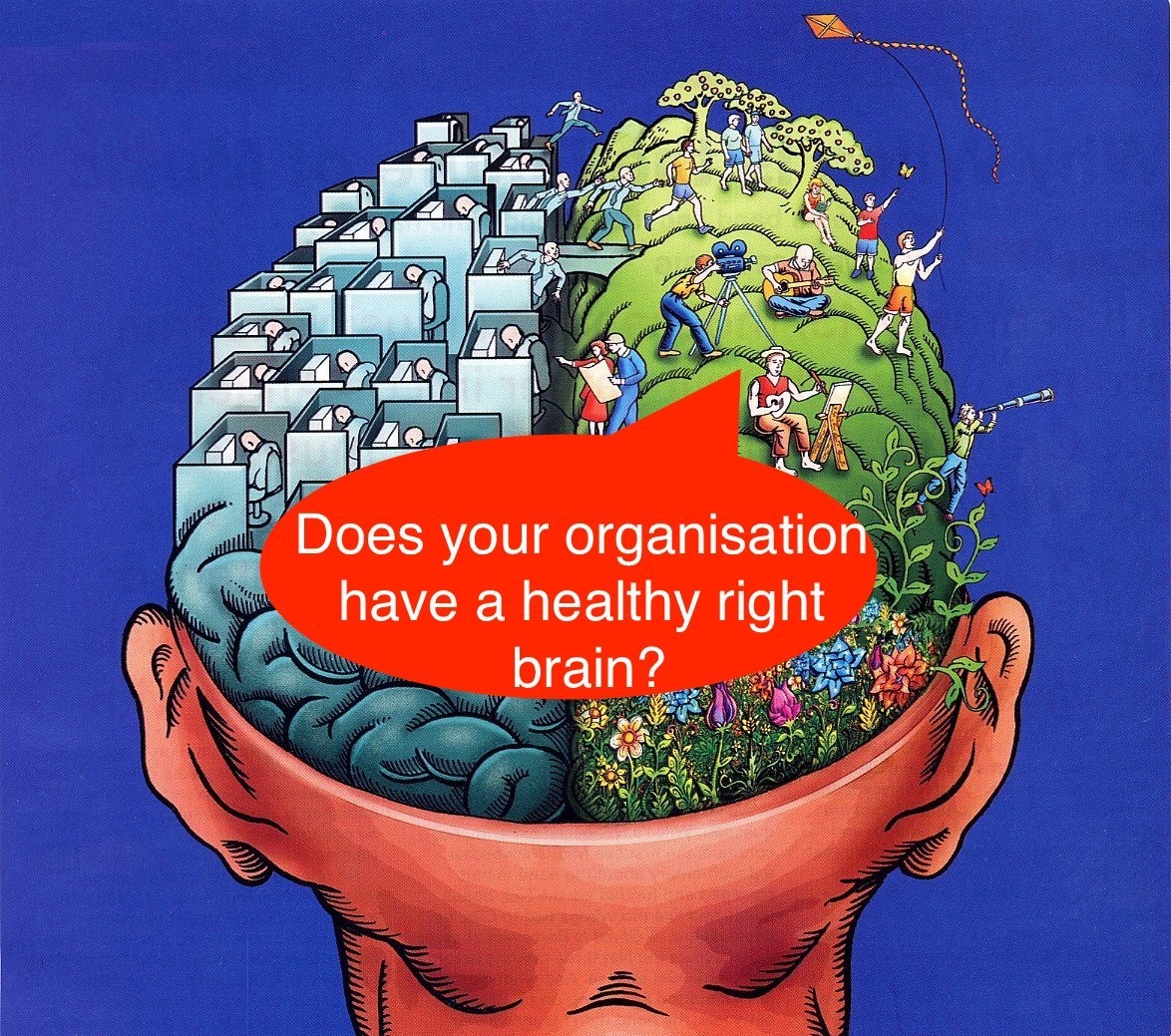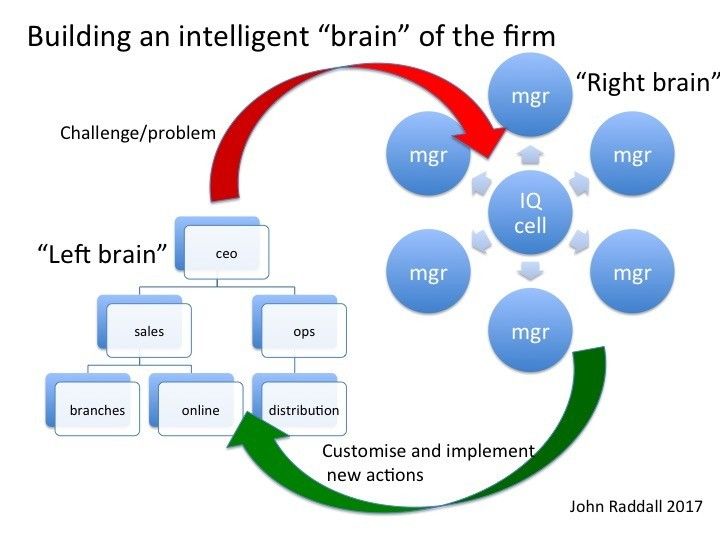Why do organisations become "brain damaged"and then die?
And how can you prevent this?
Intelligence defines our civilisation. And this intelligence may be unique in our part of the universe. Enrico Fermi, alluding to other possible civilisations in our galactic neighbourhood, famously asked "Where is everyone?" In short, we are smart but quite alone. The question, however, is: are we smart enough to survive?
This survival principle applies to every organisation. Is your organisation smart enough to survive? Has the brain of your firm already been attacked by a common but deadly virus? Put more bluntly is your organisation becoming dumber and dumber by the day? Every organisation competes on a complex and ever-changing landscape. Survival depends on the ability to innovate and adapt and this ability is a core component of intelligence.
"...Companies epitomise the triumph of scale over innovation and idea creation."
by Geoffrey West
Defining the "brain of the firm"
Neuroscientists tell us that the human brain has evolved to survive but not to understand reality. The organisational brain is no different. It has also been designed to survive. However there is a problem. Most organisations struggle to survive for longer than a decade. How can this possibly happen in a world of clouds and Googles, scientific literacy and more knowledge than ever before?
I propose that there is a mysterious virus that affects and destroys organisations. And without an effective anti-virus your company may already be in a state of terminal decline. Let's name it the DDT virus – the dumbing down over time virus.
I define the brain of the firm as the collective ability of all employees to think and act in a way that works towards the survival of the firm
Richard Branson once said that to survive in business you only have to do one thing, and that is to swim faster than the other sharks in the sea. If you cannot, get out of the water. Whether tinker, tailor, soldier, sailor, beggar man or thief every one of us must compete to survive. Which means we must learn to be smart.
Most organisations start by being creative and smart by doing something new or better than someone else. This generates revenue and growth but also attracts competitors, so a great deal of energy and intellectual effort must be directed at efficient repetition to keep costs down and quality up.
This focus on efficient repetition is a completely understandable and logical survival strategy. But herein lies the rub. This is fine in the short term but in the long term the organisation must also apply its intelligence to evolving to meet changing demand, increased competition, and new and possibly disruptive technology.
Long term survival therefore depends on one of two possible strategies. Control the market and simply outlaw all new ideas and new thinking on pain of death if necessary. Systems such as religions, political ideologies and dictatorships (sometimes a combination of all three) are past masters at this, surviving sometimes for hundreds or even thousands of years without any new thinking. If you are lucky enough to be the boss of one of these systems, the added bonus is that you probably won't have to pay tax either!
However in more enlightened landscapes where free thinking and competition are the natural drivers of progress, you simply have to be smarter than the rest. And this means organisations must evolve, metaphorically, equally powerful left brains and right brains, where the left brain drives ever increasing efficiency in repetitive and cost decreasing activities and the right brain works independently to find new and better or different ways of doing things every day.
But this creates a serious problem. In some ways the left brain efficiency mutually excludes right brain effectiveness. For the organisation to build a strong and healthy right brain requires allocating scarce left brain resources to the task. And this is a serious dilemma as such re-allocation may threaten the very survival of the firm in the short term.
This can quite naturally lead to the evolution of an unconscious, powerful and potentially deadly meta-rule that says "Don't change!" And it is exactly here that the "neuron" destroying virus creeps into the system behind the shadow of the "Don't change!" meta-rule. And the more the CEO and the management team focus on efficiency and cost control, the more the firm's right brain potential is slowly eaten away by the deadly DDT virus.
In our consulting work we often hear comments like, "People don't like or are resistant to change" or "People are afraid of change" or even "People are too lazy to change." I fundamentally disagree. People don't change because the brain of their organisation has become left brain dominated and rejects change at a deep level. People simply comply with the underlying rules of the system to make sure they get a pay check at the end of the month. The deadly nature of the virus however slowly destroys the brain of the firm, making it quite literally, dumber and dumber over time.
In a healthy organisation which has a well balanced and intelligent brain, people naturally respond positively and constructively to change that is fun, exciting, challenging and rewarding. After all, that's what being human is all about.
In support of this, over the past two decades we have surveyed over one hundred and fifty thousand leaders, employees and customers and we have learned one very important fact. Every human being is fundamentally happier and more 'alive' in a positive, high-energy environment, filled with challenge, excitement and change. In fact I would go so far as to say that change is the very breath of life.
Building the essential "anti-virus" creative right brain
The successful and practical anti-virus is to build and evolve an organisational creative "right brain" that is equally powerful and healthy as the "left brain" and is given equal time, energy and status as the "left brain". Generally I don't like the word 'balanced' but in this case it is apposite. To survive and grow an organisation needs a healthy and balanced brain.
In short a healthy right brain of the firm is the only known anti-virus to the DDT virus.
First, important notes on neuronal pathways
Your brain has about one hundred billion neurons which, interestingly, can connect in more ways than there are atoms in the known universe. Although it is often compared to a muscle it is quite the opposite. It has a plasticity which allows it to change and evolve over time. Regardless of age, if you start something new like learning a different language or playing a musical instrument, your brain will develop continuously and improve its overall capability.
However to control the almost infinite complexity in your brain you develop neuronal pathways over time that give you meaning, defining your beliefs, values, thinking and behaviour.
In many ways these neuronal pathways are like the pathways animals create moving down to watering holes.
However in the bush if a watering hole dries up the animals will move on and the pathways will gradually grow over and eventually disappear. We can use exactly the same principle with organisations in developing a new and more intelligent brain of the firm, through building new and more powerful pathways and destroying the old and destructive ones.
This is how we do it
The diagram below shows how we build balanced, virus free, and intelligent brains in organisations, converting the theory into practice.
The left brain is the logical and structured side, filled with silos, rules and hierarchies that drives repetition, efficiency and cost reduction. The right brain is a separate structure that sits outside the traditional structure, much like a satellite circling the earth, seeing everything, gathering data, solving complex problems and relaying solutions back to earth for efficient implementation.
Key to the right brain structure is that it must float independently of the hierarchical power structure and its politics, and just as the left and right brains of humans are connected by the corpus callosum, so too must there be a formal communication structure between the healthy hemispheres in the intelligent organisational brain.
If you are a CEO or senior manager in your organisation, here are some basic steps you may wish to consider.
Find out how healthy your firm's right brain is compared to the left brain. Keep it simple. Use a one to ten scale and ask employees three questions.
- How efficient are we in what we produce?
- How creative and innovative are we?
- Do we use your full creative potential at work?
This will give you a quick insight into the health of your firm's brain and its current level of intelligence, as well as the possible impact of the DDT virus.
- Establish a right brain creative team or "IQ Cell". Use as many young and smart people as possible. They are generally sharper and more creative than the "old dogs'.
- Give them any important task linked to your strategic objectives, such as growth, profitability, customer experience, B2B, B2C etc, that requires deeper, fresh and intelligent thinking.
- Give them absolute freedom and executive support to go anywhere, ask anything.
- Allow them the freedom to analyse and recommend new and creative action.
- If you approve the recommended action send this to the left brain structure for efficient implementation.
Extensive research (Mckinsey) on nearly 30,000 companies over sixty years reveals an immutable law that regardless of size, every company has a half-life of ten years. This means that of all the companies formed in any given year, fifty percent will have disappeared within ten years. If you don't wish to be part of this statistic, start building a powerful "right brain" for your organisation. Today.
Comments
By accepting you will be accessing a service provided by a third-party external to https://quanta.consulting/




